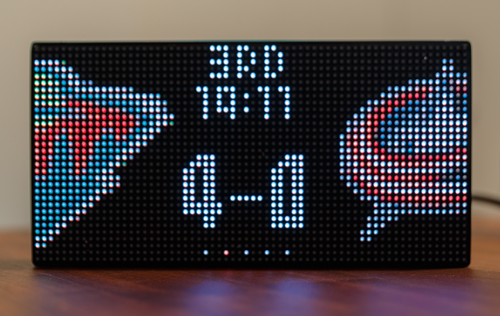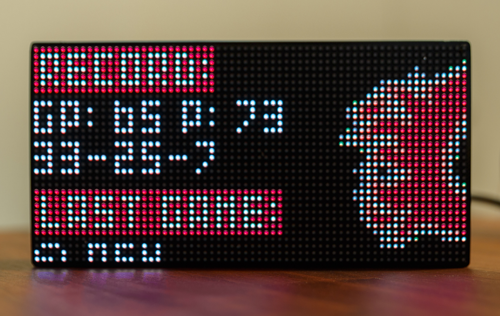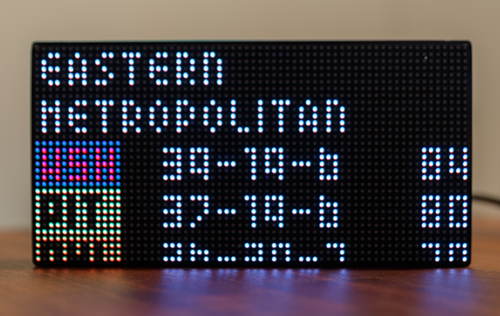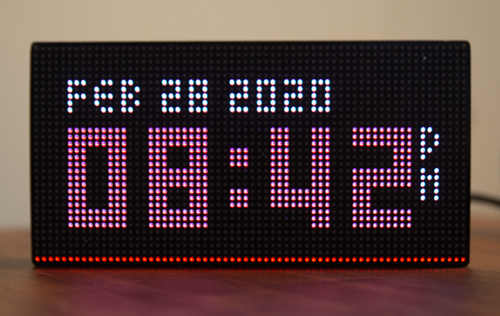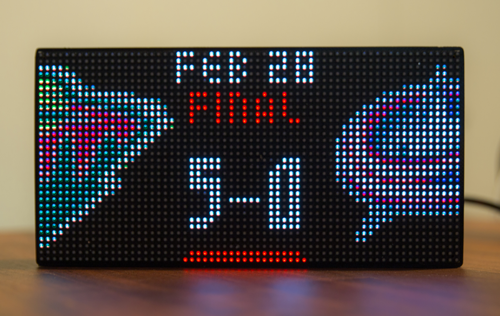The scoreboard now handles the postponed games.
Bug fix:
- Updated the nhl_setup with a different message if not config.json file exist
- Fixed Bug mentioned in Issue #82 about Off_day showing only 2 boards.
-
New setup app. no more need to fiddle with the config.json file. Just run
./nhl_setuponce you finished installing the software to config your scoreboard. Please take a look at the documentation here: src/nhl_setup/README.md -
New Covid-19 stats board. Just add "covid_19" to any state of the board to see the latest worldwide cases, deaths and recovered cases of the virus.
We have a nice community growing every day on discord. If you need help or you are curious about the development of the project, come join us by clicking on this button.
Want to help me turn coffee into features? Or just want to contribute for my work?
"I followed instructions from somewhere else and I'm having issues"
This project is new and is in constant evolution. Please read the documentation and instructions to install and run this software provided here.
You need Git to clone this repo and PIP3 for installing the scoreboard software.
Since version V1.0.0 you need python 3.3 and up. Run these two commands in your terminal to install git and PIP3.
sudo apt-get update
sudo apt install git python3-pip
- Features
- Time and data accuracy
- Installation
- Testing and Optimization
- Configuration
- Usage
- Shout-out
- Licensing
Depending on the situation, the scoreboard will operate in a different state. For example, If your team is off today, the scoreboard will be in the "Offday" State. This allows showing specific boards (see Boards) depending on the state of the unit.
- Scheduled: When one of your preferred team has a game scheduled on the current day, the scoreboard will rotate through a list of boards set by the user in the config file.
- Live game: Display the live score in near real-time of your favorite game. If one of the team scores a goal, a goal animation (.gif) is played.
- Intermission: Between periods, the scoreboard will rotate through a list of boards set for the intermission state by the user in the config file.
- Post-game: Once the game is over, the scoreboard will rotate through a list of boards set for the Post-game state by the user in the config file.
The board system allows the user to choose what to display depending on the state of the scoreboard. For example: While the game I'm watching is in the intermission state, I like to see the score ticker, which is showing the score of the other games.
There are currently three different boards available:
- Score Ticker: A carousel that cycles through the games of the day.
- Team Summary: Display your preferred team's summary. It displays their standing record, the result of their previous game and the next game on their schedule.
- Standings: Display the standings either by conference or by division. The Wildcard is a work in progress and will be available soon.
- Clock: a basic clock.
- Covid-19: Show the number of cases, deaths and recovered cases of the covid-19 virus in real time (API updates about every 15 min).
The board system also allows to easily integrate new features. For example, if you want to have a clock displayed during the day along with other boards, or if you wish one of the existing boards would show something different, you can make your own and integrate it without touching the main software. I strongly suggest you play around with the python examples in the rpi-rgb-led-matrix to learn how to display anything on the matrix.
More will come soon with playoff related features
When ever a team in the main event score a goal, a goal light animation is played. Soon you will have to option to set the animation for your favorite team only or play a different animation for the opposing team.The scoreboard now has a dimmer function. The scoreboard will change its brightness at sunrise and sunset. If you have a TSL2591 light sensor installed on your raspberry pi, you can configure the scoreboard to use it to adjust the brightness.
Because of its size, I programmed some indicators to display more information without filling up the screen and create an information overload issue. Please read the Indicators page in the Wiki section for more details.
For this version, the scoreboard refreshes the data at a faster rate (15 seconds by default, don't go faster than 10). This does not change the fact that the data from the API is refreshed every minute. The faster refresh rate allows catching the new data from the API faster.
Syncing the scoreboard with a TV Broadcast is, to my knowledge, impossible. The delay between the actual game and the TV broadcast is different depending on where you are in relation to the game's location. This also means that you will see the goal animation before it happens on TV. I'm working on this issue and looking to find a solution to implement a delay.
Also, it might happen the data shown on board might be wrong for a short time, even goals. That's because the API is drunk. If you see data that might be wrong, compare it to the nhl.com and see if it's different.
IMPORTANT NOTE: Even tho there are other ways to run an rgb led matrix, I only support for the Adafruit HAT and Adafruit Bonnet. If you create an issue because you are having trouble running your setup and you are using something different, I will close it and tell you to buy the appropriate parts or to check the rpi-rgb-led-matrix repo.
Please refer to the Home page and Hardware page in the wiki section. You will find everything you need to order and build your scoreboard.
To install and configure a button, please refer the well writen and detailed documentation in the SBIO section here: src/sbio/SBIO.md.
To be sure that you have the best performance possible, this project requires Raspbian Buster Lite. This version does not have a GUI which allows the Pi to dedicate as much resource as possible to the scoreboard.
Follow these instructions to install Raspbian Buster Lite on your Raspberry Pi and once you are up and running comeback to this page.
Raspbian Buster Lite Installation
Before you start installing anything, make sure your raspberry pi is set to your local time zone. Usually, you do so when you install Raspian, but if you think you skipped that part, you can change it by running sudo raspi-config
This installation process might take some time because it will install all the dependencies listed below.
git clone --recursive https://github.com/riffnshred/nhl-led-scoreboard
cd nhl-led-scoreboard/
sudo chmod +x scripts/install.sh
sudo ./scripts/install.sh
rpi-rgb-led-matrix : The open-source library that allows the Raspberry Pi to render on the LED matrix. requests: To call the API and manipulate the received data.
If it's a first install of the software, there is not config.json only a config.json.sample. This is normal. You need to configure your scoreboard. Fallow the steps in the Configuration section of this documentation.
If you undate from any version that was released before V1.0.0, run these commands to update.
git reset --hard
git checkout master
sudo git pull
sudo chmod +x scripts/install.sh
sudo ./scripts/install.sh.
If your board runs any V1 version, simply run the install like so.
sudo chmod +x scripts/install.sh
sudo ./scripts/install.sh
If you face any issue after updating, rerun the install and it should fix it. otherwise check the issue section to see if a solution as been found for your problem. If not open an issue and I'll find a solution.
If you have been using a Led matrix on a raspberry pi before and know how to run it properly skip this part.
If you just bought your Led matrix and want to run this software right away, first thank you. Second, don't get too excited just yet. Depending on your setup, you will need to configure the scoreboard using specific command flags when you run it.
To do so, start by disabling the audio of the raspberry pi (this is a must to run the led matrix properly). From the root of the pi open the boot config file like so.
sudo nano /boot/config.txt
Find dtparam=audio=on and change it to dtparam=audio=off.
Save and close the file like so
Press Control-x
Press y
Press [enter]
reboot the pi
sudo reboot now
Now let's show something on the screen. Get to the matrix submodule and run some samples.
cd nhl-led-scoreboard/submodules/matrix/bindings/python/samples
sudo python3 runtext.py --led-rows=32 --led-cols=64 --led-gpio-mapping=adafruit-hat --led-brightness=60
If you've done the anti-flickering mod, use this flag instead --led-gpio-mapping=adafruit-hat-pwm
You should see "Hello World" scroll on screen.
Reference the rpi-rgb-led-matrix library. Check out the section that uses the python bindings and run some of their examples on your screen. For sure you will face some issues at first, but don't worry, more than likely there's a solution you can find in their troubleshooting section. Once you found out how to make it run smoothly, come back here and do what's next.
This is a list of Flags you can use to optimize your screen's performance. For more details check out the rpi-rgb-led-matrix library.
--led-rows Display rows. 16 for 16x32, 32 for 32x32 and 64x32. (Default: 32)
--led-cols Panel columns. Typically 32 or 64. (Default: 32)
--led-chain Daisy-chained boards. (Default: 1)
--led-parallel For Plus-models or RPi2: parallel chains. 1..3. (Default: 1)
--led-pwm-bits Bits used for PWM. Range 1..11. (Default: 11)
--led-brightness Sets brightness level. Range: 1..100. (Default: 100)
--led-gpio-mapping Hardware Mapping: regular, adafruit-hat, adafruit-hat-pwm
--led-scan-mode Progressive or interlaced scan. 0 = Progressive, 1 = Interlaced. (Default: 1)
--led-pwm-lsb-nanosecond Base time-unit for the on-time in the lowest significant bit in nanoseconds. (Default: 130)
--led-show-refresh Shows the current refresh rate of the LED panel.
--led-slowdown-gpio Slow down writing to GPIO. Range: 0..4. (Default: 1)
--led-no-hardware-pulse Don't use hardware pin-pulse generation.
--led-rgb-sequence Switch if your matrix has led colors swapped. (Default: RGB)
--led-pixel-mapper Apply pixel mappers. e.g Rotate:90, U-mapper
--led-row-addr-type 0 = default; 1 = AB-addressed panels. (Default: 0)
--led-multiplexing Multiplexing type: 0 = direct; 1 = strip; 2 = checker; 3 = spiral; 4 = Z-strip; 5 = ZnMirrorZStripe; 6 = coreman; 7 = Kaler2Scan; 8 = ZStripeUneven. (Default: 0)
Using either a raspberry Zero, 3B+, 3A+ and 4B with an Adafruit HAT or Bonnet, here's what I did to run my board properly.
- Do the hardware mod found in the Improving flicker section.
- Disable the onboard sound. You can find how to do it from the Troubleshooting sections
- From the same section, run the command that removes the Bluetooth firmware, Unless you use any Bluetooth device with your Pi.
Finally, these are the flag I use. (ONLY USE THESE FLAGS IF YOU'VE DONE THE HARDWARD ANTI-FLICKERING MOD. If not, replace the first flag with --led-gpio-mapping=adafruit-hat).
--led-gpio-mapping=adafruit-hat-pwm --led-brightness=60 --led-slowdown-gpio=2
First thing first, Open the config.json file from the config directory to configure your scoreboard.
Since V1.1.2, you won't need to reconfigure your board everytime you update, UNLESS we add a major feature or we make a major update. There is 2 way to configure you board:
from the root of the nhl-led-scoreboard, run this command: ./nhl_setup. Please take a look at the documentation here: src/nhl_setup/README.md
If you have no issue working with json files in a prompt, you can still configure manualy. FIRST, you will need to make a copy of the config.json.sample and rename it config.json. Then open it and modify the options.
These are options to set the scoreboard to run in a certain mode. This is where you enable the live game mode while will show the scoreboard of your favorite game when it's live.
| Settings | Type | Parameters | Description |
|---|---|---|---|
debug |
Bool | true, false | Enable the debug mode which show on your console what the scoreboard |
live_mode |
Bool | true, false | Enable the live mode which show live game data of your favorite team. |
All the data related options.
| Settings | Type | Parameters | Description |
|---|---|---|---|
live_game_refresh_rate |
INT | 15 |
The rate at which a live game will call the NHL API to catch the new data. Do not go under 10 seconds as it's pointless and will affect your scoreboard performance.(Default 15 sec) |
time_format |
String | "12h" or "24h" |
The format in which the game start time will be displayed. |
end_of_day |
String | "12:00" |
A 24-hour time you wish to consider the end of the previous day before starting to display the current day's games. |
teams |
Array | ["Canadiens", Blackhawks", "Avalanche"] |
List of preferred teams. First one in the list is considered the favorite. If left empty, the scoreboard will be in "offday" mode |
The goal animations can be set for both teams of just the preferred teams. MORE OPTIONS COMING SOON
| Settings | Type | Parameters | Description |
|---|---|---|---|
pref_team_only |
Bool | true, false |
self explanatory |
For the teams parameters, only put the team's name. You can copy and paste your team's name from this table.
| Team names | Team names |
|---|---|
Avalanche |
Jets |
Blackhawks |
Kings |
Blues |
Leafs |
Blue Jackets |
Lightning |
Bruins |
Oilers |
Canadiens |
Panthers |
Canucks |
Penguins |
Capitals |
Predators |
Coyotes |
Rangers |
Devils |
Red Wings |
Ducks |
Sabres |
Flames |
Senators |
Flyers |
Sharks |
Golden Knights |
Stars |
Hurricanes |
Wild |
Islanders |
If the live mode is enabled, the scoreboard will go through different states depending on the current situation.
For each state, you can define which of the available board you want the scoreboard to show. For example, if one of my preferred
team has a game scheduled on the current day, during the day, the scoreboard will be in the scheduled state. I personally like
to have all the data possible shown during the day so I'll set the all the boards in the scheduled setting.
| Settings | Type | Parameters | Description |
|---|---|---|---|
off_day, scheduled, intermission, post_game |
Array | ["scoreticker", team_summary", "standings", "clock", "covid_19] |
List of preferred boards to show for each specific state. |
Boards are essentially like pages on a website. Each of them shows something specific and the user can decide which board to display
depending on the state of the scoreboard. Currently, there are only three boards available:
- Score Ticker: This is basally like the generic score ticker you see during a game on TV of sports news showing the
- result or the status of the other games in the league.
- Standings: Self-explanatory, it shows the current standings. Currently, you can choose between showing standings by conference or by divisions. Wildcard standings are coming soon.
- Team Summary: Show a summary of your preferred teams. It includes data like standing record, Result of the previous game and the next scheduled game.
- Clock: Show the current time either in 24h or 12h format.
- Covid_19: Show the number of cases, deaths and recovered cases of the covid-19 virus in real time (API updates about every 15 min).
| Boards | Settings | Type | Parameters | Description |
|---|---|---|---|---|
scoreticker |
preferred_teams_only |
Bool | true, false |
Choose between showing all the games of the day or just the ones your preferred teams are playing |
rotation_rate |
INT | 5 |
Duration at witch each games are shown on screen. | |
standings |
preferred_standings_only |
Bool | true, false |
Choose between showing all the standings or only the the preferred division and conference. |
standing_type |
String | conference, division , wild_card |
Option to choose the type of standings to display. conference if set by default. |
|
divisions |
String | atlantic, metropolitan, central, pacific |
Your preferred division | |
conference |
String | eastern, western |
Your preferred conference |
The scoreboard can adjust the brightness of the matrix will running using the Dimmer function. By default, if enabled, the scoreboard software will detect your location using your IP address and will calculate the when the sun rise and the sun set. It will then use these moments to change the brightness of the screen depending on the parameters set in the config.
If you install the TSL2591 lux sensor, you can tell the scoreboard to use that to control the brightness instead.
| Settings | Type | Parameters | Description |
|---|---|---|---|
enabled |
Bool | true, false |
Enable the dimmer or not |
source |
String | "hardware", "software" |
Select the source that controle the dimmer. If set to "software", the scoreboard will find your latitude and longitude based on your IP address. If an adafruit TSL2591 light sensor is connected to the Pi, you can set the source to "hardware" and let the sensor control the brightness. |
light_level_lux |
INT | 400 |
This is the value you want the light sensor to start changing the brightness at |
frequency |
INT | 5 |
Frequency at which the scoreboard will look if it needs to change the brightness |
mode |
String | "always", "offday" |
Mode at which the dimmer will operate. If set at "always", the dimmer will operate at all time. at "offday", it will operate only when your preferred teams don't play any games. |
sunset_brightness |
INT | 10 |
The brightness level (between 5 and 100) you want when it's night. |
sunrise_brightness |
INT | 60 |
The brightness level (between 5 and 100) you want during the day. |
Once you are done optimizing your setup and configuring the software, you are ready to go.
Start by running your board and see if it runs properly. If you use the typical Pi 3b+ and HAT/Bonnet setup, here's the command I use.
If you've done the anti-flickering mod, change the --led-gpio-mapping=adafruit-hat for --led-gpio-mapping=adafruit-hat-pwm
sudo python3 src/main.py --led-gpio-mapping=adafruit-hat --led-brightness=60 --led-slowdown-gpio=2
Once you know it runs well, turn off your command prompt. SURPRISE !!! the screen stop! That's because the SSH connection is interrupted and so the python script stopped.
There are multiple ways to run the Scoreboard on it's own. I'm going to cover 2 ways. One that's a bit more hand's on, and the other will run the board automatically (and even restart in case of a crash).
Supervisor is a Process Control System. Once installed and configured it will run the scoreboard for you and restart it in case of a crash. What's even better is that you can also control the board from your phone !!!!
To install Supervisor, run this installation command in your terminal.
sudo apt-get install supervisor
Once the process done, open the supervisor config file,
sudo nano /etc/supervisor/supervisord.conf
and add those two lines at the bottom of the file.
[inet_http_server]
port=*:9001
Close and save the file.
Press Control-x
Press y
Press [enter]
Now lets create a new file called scoreboard.conf into the conf.d directory of supervisor, by running this command,
sudo nano /etc/supervisor/conf.d/scoreboard.conf
In this new file copy and past these line.
[program:scoreboard]
command=[SCOREBOARD COMMAND]
directory=[LOCATION OF THE SCOREBOARD DIRECTORY]
autostart=true
autorestart=true
Than fill in the missing information. For the command, insert the command that worked for you when you tested the scoreboard. If
you used the same as mine then this line should look like, command=sudo python3 src/main.py --led-gpio-mapping=adafruit-hat-pwm --led-brightness=60 --led-slowdown-gpio=2.
Lastly, for the directory, insert the location of the scoreboard directory. It should be something like /home/{user}/nhl-led-scoreboard. If you use the base account "pi" then
the {user} will be pi.
Now, reboot the raspberry pi. It should run the scoreboard automatically. Open a browser and enter the ip address of your raspberry pi in the address bar
fallowing of :9001. It should look similar to this 192.168.2.19:9001. You will see the supervisor dashboard with the scoreboard process running.
If you see the dashboard but no process, reboot the pi and refresh the page.
You should be up and running now. From the supervison dashboard, you can control the process of the scoreboard (e.g start, restart, stop).
To troubleshoot the scoreboard using supervision, you can click on the name of the process to see the latest log of the scoreboard. This is really useful to know what the scoreboard is doing in case of a problem.
To make sure it keeps running you will need a Terminal Multiplexer like. Screen. This allows you to run the scoreboard manually in a terminal and To install Screen, run the fallowing in your terminal.
sudo apt install screen
Then start a screen session like so
screen
Now run the scoreboard. Once it's up and running do Ctrl+a then d. This will detach the screen session from your terminal.
NOW ! close the terminal. VOILA !!! The scoreboard now runs on it's own.
To go back and stop the scoreboard, open your terminal again and ssh to your Pi. Once you are in, do screen -r. This will bring the screen session up on your terminal.
This is useful if the scoreboard stop working for some reason, you can find out the error it returns and uses that to find a solution.
First, these two for making this repo top notch and already working on future versions:
This project was inspired by the mlb-led-scoreboard. Go check it out and try it on your board, even if you are not a baseball fan, it's amazing. I also used this nhlscoreboard repo as a guide at the very beginning as I was learning python.
You all can thank Drew Hynes for his hard work on documenting the free nhl api.
This project uses the GNU Public License. If you intend to sell these, the code must remain open source.



